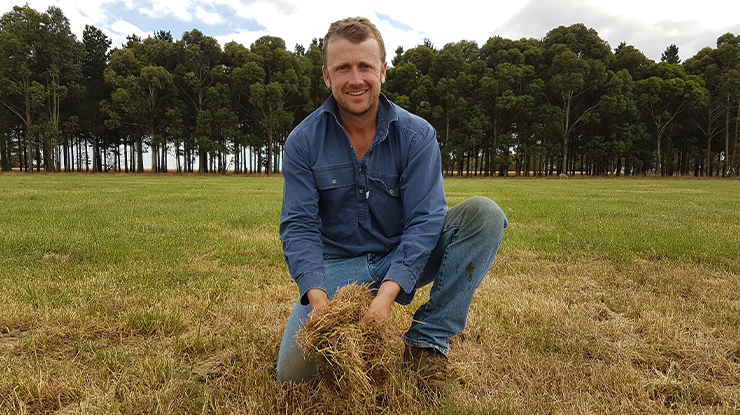No summer holiday for sub-clover management
14 January 2021
 Grazing down dry matter over summer is a top priority for Simon Gabb. Image: Jess Brogden
Grazing down dry matter over summer is a top priority for Simon Gabb. Image: Jess Brogden
Western Victorian producers Simon and Alistair Gabb have lifted stocking rates at their Skipton property from 4.5 ewes/ha to 8.5/ha with a focus on sub-clover management.
The brothers returned to the family cropping and livestock operation – which had been leased for 12 years – after studying and working off farm. They reintroduced sheep to the business five years ago, and they set out to improve pastures and lift sub-clover content from 5–10% up to as much as 70% in some paddocks.
A key change that contributed to pasture performance has been managing summer trash removal in order to expose buried sub-clover seed to fluctuating temperatures over late summer. This breaks down the hard seed coat, enabling it to germinate once temperatures falls and the autumn rains come.
“It is important that over summer, before March comes around, we pull that dry matter (DM) back with sheep, taking it back to 1,000kg DM/ha and let it do its thing,” Simon said.
“If we cannot remove that dry matter and get enough mouths on it, we’ll slash the arable paddocks to try and speed up that process.”
In the Gabbs’ larger paddocks, where they don’t join ewes in, they aim to reduce back to 1,000kg DM/ha before joining starts on 1 February.
Otherwise, these paddocks won’t get grazed again until early March.
The Gabbs join on a combination of pasture and cropping paddocks, focusing on keeping paddock size as practically small as possible to ensure ram to ewe contact is fully maximised.
In paddocks that the Gabbs will use for joining, they target 1,500kg DM/ha – during the five-week joining period, this dry matter will most likely be reduced back to 1,000kg/ha by the end of February.
Here are some of the Gabbs’ other strategies to manage their feedbase:
1. Be on the front foot
This focus on grass pressure and dry matter removal starts in late spring.
“We make sure we always prioritise clover for lambs and weaners, and ewes get the higher grass content pastures,” Simon said.
“Lambs won’t eat them when the grasses run to head – they just keep pushing through trying to find green picks and clover, whereas the ewes will just go through and eat everything.”
2. Smaller paddocks
To achieve sufficient and timely grazing the Gabbs have reduced paddock sizes from 25–35ha to 15-20ha to help with grazing pressure and lamb survivability.
They lamb down in the smaller mobs of 150 ewes or less.
“Paddock size definitely helps to manage dry matter over the summer,” Simon said.
“In our stony country, paddocks are still 45-65 ha and it’s an effort to graze down sufficiently whereas in 15–20 ha paddocks we can efficiently graze those in a short amount of time and get a really even cover of dry matter with high stocking rates.”
The Gabbs plan to reduce the stony paddocks into 15ha paddocks over the next two years to encourage greater grazing pressure and paddock utilisation.
3. Combining mobs
To achieve high stocking rates, mobs are often run together.
“We happily box up mobs. At weaning, all our mature ewes get boxed up into two or three mobs.
“The only ewes we don’t box are our maidens. They stay in their age group until their second joining, to grow and put condition back on pre-joining, but everything else remains boxed up right through until four weeks before joining.”
Sheep eating clover burr and reducing possible seed for germination in summer isn’t an issue as the Gabbs utilise their stubble cropping country.
This case study was written by Jess Brogden, Southern Farming Systems, as part of the Feedbase Adoption Plan, supported by MLA.


